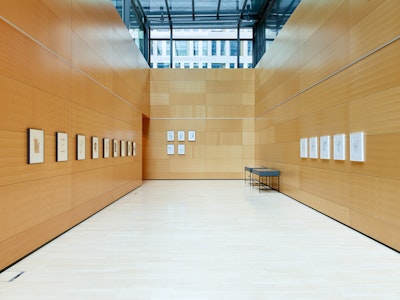Art Cube exhibition cycle
BERT THEIS
PAYS SAGES 1991
Collages and Drawings from the Bert Theis Archive Collection
A collaborative exhibition from the Bert Theis Archive, Erna Hecey Galerie, Art contemporain.lu a.s.b.l and the Chamber of Commerce
Presentation
At the crossroads between random signs and geometric compositions, the exhibition “Pays sages 1991” assembles a corpus of Bert Theis’s drawings and collages never yet revealed to the public. Theis produced these sketches in Italy between 1990 and 1992, while studying at the Accademia di Belle Arti di Roma.
Thanks to the major retrospective “Bert Theis: Building Philosophy-Cultivating Utopia” held at MUDAM Luxembourg in spring 2019, a sizeable part of Bert Theis’s activity prior to the 1990s emerged, revealing works produced before the pavilions and platforms for which he achieved international acclaim. The particularity of this group of enigmatic collages from 1991 is the important role they play in marking the transition from his truly figurative collages of the 1980s (in which Max Ernst is a sort of spiritual forefather) to his prominent use of white as a strong, persistent and anti-pollutant sign in subsequent work. In fact, Theis would repeatedly return to collage in the years that followed, mainly in pieces connected to city- and landscapes, as in the well-known Aggloville series.
With Pays sages Bert Theis also comes to terms with painting (hence with his background training), which would lead him in 1994 to glue together all the pages of the book L’Art de la Peinture and to apply a brushstroke of white paint to a white wall, as a tribute to Vincent van Gogh. When considering 1995 as the year of Potemkin Lock at the Venice Biennale, it becomes clear that these collages – made a few years earlier – require a broader interpretation within Theis’ career in relation to a long-term study in progress.
But what exactly are the pieces presented in “Pays sages 1991”? They seem to possess a cartographic quality, with tectonic shifts, seen from above, in which strips of different paper create tactile and graphic reliefs, like orographic maps of a real landscape. Theis often squares off the sheet, drawing a sort of rectangular border in which random or accidental signs left in ink and pencil encounter colored paper, some recursive figuration or certain phrases with a suspended meaning. This is a fluid space in which the previous figurative collages remain as simple abstract fragments that float (becoming tangent or overlapping) on the white page. The resulting impression is that of a potential space that draws Bert Theis increasingly away from the text (the painted or in any case graphic work) and closer to the context (the place, the urban and social dimension, etc.).
If we think about the series Shadow Fixing and the black signs Theis painted on the ground in an attempt to “fix” shadows, we understand that the Pays sages are true forebears. It is no coincidence that much of Theis’ work from then on would be committed to searching for places in which to intervene.
Like a travel journal made up of delicate signs, the ensemble presented, of fourteen collages and five drawings on paper, renders the artist’s poetic and emotional response to his natural surroundings. Offering a new, perhaps more intimate insight into his work, “Pays sages 1991” is presented for the first time at the Chambre de Commerce, Luxembourg, from 8 October to 18 December 2020.
Biography of Bert Theis
Bert Theis (1952-2016) was an artist and activist who explored through his work themes linked to ecological policies, urbanisation and gentrification. His international acclaim arose at the 1995 Venice Biennale, where he represented Luxembourg. Theis was mostly known for his large site-specific urban installations in densely populated areas, based on public platforms and pavilions in parks. In the 2000s, he organised and directed two long-term projects – Isola Art Center and out-Office for Urban Transformation – in collaboration with Mariette Schiltz.
Although most of his works were created in situ, Bert Theis also participated in many international exhibitions and events. Most recently, a monographic exhibition was held at the MUDAM - Musée d'Art Moderne du Luxembourg Grand Jean-Duc entitled Building Philosophy - Cultivating Utopia (2019), which was accompanied by a series of actions under the name of Archipelago Bert Theis. Other major personal exhibitions include Padiglione d’Arte Vivente, Torino, Italy (2015), Erna Hecey Gallery, Brussels (2008), MAMCO – Musée d’art moderne et contemporain, Geneva, Switzerland (2007), and Erna Hecey Gallery, Luxembourg (1999 and 2003).
He has been part of numerous international group exhibitions, i.e. MUDAM, Luxembourg (2020); Le Printemps de Septembre, Toulouse (2018); MOCAK – Museum of Contemporary Art in Krakow (2016); CNAP and Galerie Fernand Léger, Ivry-sur-Seine (2015); Pavillon de l’Arsenal, Paris , (2016); Vienna Secession, Austria (2014); MAXXI, Museo nazionale delle arti del XXI secolo, Rome (2014); Castello di Rivoli, Torino, Italy (2013); Mudam, Luxembourg (2012, 2006); the Venice Biennale (2011); The 10th Istanbul Biennial (2007), Skulptur Projekte Münster (1997) and Biennale de Venise (1995).
Permanent installations can be found at Parc de la Butte du Chapeau Rouge, Paris; Luicciana di Cantagallo, Italy; MNHA Musée National d’Histoire et d’Art du Luxembourg and Place de l’Europe - Kirchberg, Luxembourg.
Adress: Chambre de Commerce Luxembourg-Kirchberg
7 Rue Alcide de Gasperi, 2981 Luxembourg
More information: https://www.cc.lu/en/news/detail/pays-sages-1991-dessins-et-collages-de-la-collection-darchive-bert-theis/
